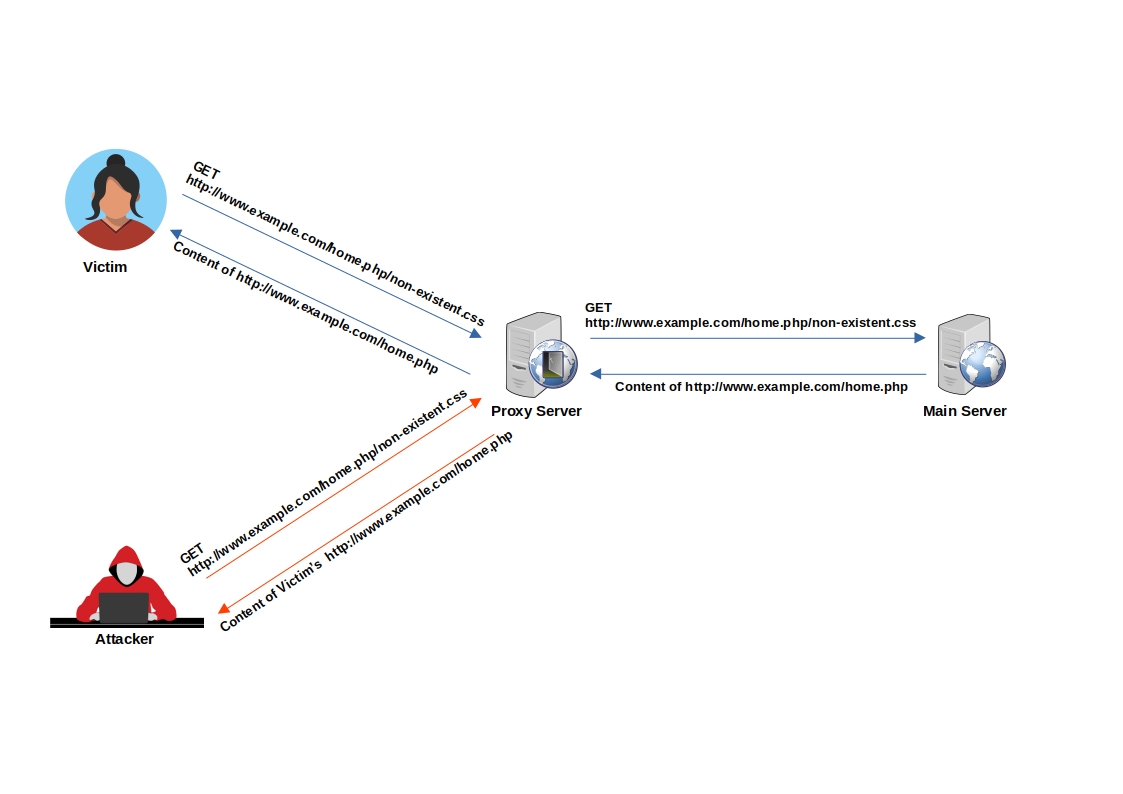Web Cache Deception
Web Cache Deception (WCD) is a security vulnerability that occurs when a web server or caching proxy misinterprets a client's request for a web resource and subsequently serves a different resource, which may often be more sensitive or private, after caching it.
Summary
Tools
- PortSwigger/param-miner - Web Cache Poisoning Burp Extension
Methodology
Example of Web Cache Deception:
Imagine an attacker lures a logged-in victim into accessing http://www.example.com/home.php/non-existent.css
- The victim's browser requests the resource
http://www.example.com/home.php/non-existent.css - The requested resource is searched for in the cache server, but it's not found (resource not in cache).
- The request is then forwarded to the main server.
- The main server returns the content of
http://www.example.com/home.php, most probably with HTTP caching headers that instruct not to cache this page. - The response passes through the cache server.
- The cache server identifies that the file has a CSS extension.
- Under the cache directory, the cache server creates a directory named home.php and caches the imposter "CSS" file (non-existent.css) inside it.
- When the attacker requests
http://www.example.com/home.php/non-existent.css, the request is sent to the cache server, and the cache server returns the cached file with the victim's sensitivehome.phpdata.

Caching Sensitive Data
Example 1 - Web Cache Deception on PayPal Home Page
- Normal browsing, visit home :
https://www.example.com/myaccount/home/ - Open the malicious link :
https://www.example.com/myaccount/home/malicious.css - The page is displayed as /home and the cache is saving the page
- Open a private tab with the previous URL :
https://www.example.com/myaccount/home/malicious.css - The content of the cache is displayed
Video of the attack by Omer Gil - Web Cache Deception Attack in PayPal Home Page
Example 2 - Web Cache Deception on OpenAI
- Attacker crafts a dedicated .css path of the
/api/auth/sessionendpoint. - Attacker distributes the link
- Victims visit the legitimate link.
- Response is cached.
- Attacker harvests JWT Credentials.
Caching Custom JavaScript
-
Find an un-keyed input for a Cache Poisoning
-
Cache poisoning attack - Example for
X-Forwarded-Hostun-keyed input (remember to use a buster to only cache this webpage instead of the main page of the website)
Tricks
The following URL format are a good starting point to check for "cache" feature.
https://example.com/app/conversation/.js?testhttps://example.com/app/conversation/;.jshttps://example.com/home.php/non-existent.css
CloudFlare Caching
CloudFlare caches the resource when the Cache-Control header is set to public and max-age is greater than 0.
- The Cloudflare CDN does not cache HTML by default
- Cloudflare only caches based on file extension and not by MIME type: cloudflare/default-cache-behavior
In Cloudflare CDN, one can implement a Cache Deception Armor, it is not enabled by default.
When the Cache Deception Armor is enabled, the rule will verify a URL's extension matches the returned Content-Type.
CloudFlare has a list of default extensions that gets cached behind their Load Balancers.
| 7Z | CSV | GIF | MIDI | PNG | TIF | ZIP |
| AVI | DOC | GZ | MKV | PPT | TIFF | ZST |
| AVIF | DOCX | ICO | MP3 | PPTX | TTF | CSS |
| APK | DMG | ISO | MP4 | PS | WEBM | FLAC |
| BIN | EJS | JAR | OGG | RAR | WEBP | MID |
| BMP | EOT | JPG | OTF | SVG | WOFF | PLS |
| BZ2 | EPS | JPEG | SVGZ | WOFF2 | TAR | |
| CLASS | EXE | JS | PICT | SWF | XLS | XLSX |
Exceptions and bypasses:
- If the returned Content-Type is application/octet-stream, the extension does not matter because that is typically a signal to instruct the browser to save the asset instead of to display it.
- Cloudflare allows .jpg to be served as image/webp or .gif as video/webm and other cases that we think are unlikely to be attacks.
- Bypassing Cache Deception Armor using .avif extension file - fixed
Labs
References
- Cache Deception Armor - Cloudflare - May 20, 2023
- Exploiting cache design flaws - PortSwigger - May 4, 2020
- Exploiting cache implementation flaws - PortSwigger - May 4, 2020
- How I Test For Web Cache Vulnerabilities + Tips And Tricks - bombon (0xbxmbn) - July 21, 2022
- OpenAI Account Takeover - Nagli (@naglinagli) - March 24, 2023
- Practical Web Cache Poisoning - James Kettle (@albinowax) - August 9, 2018
- Shockwave Identifies Web Cache Deception and Account Takeover Vulnerability affecting OpenAI's ChatGPT - Nagli (@naglinagli) - July 15, 2024
- Web Cache Deception Attack - Omer Gil - February 27, 2017
- Web Cache Deception Attack leads to user info disclosure - Kunal Pandey (@kunal94) - February 25, 2019
- Web Cache Entanglement: Novel Pathways to Poisoning - James Kettle (@albinowax) - August 5, 2020
- Web cache poisoning - PortSwigger - May 4, 2020